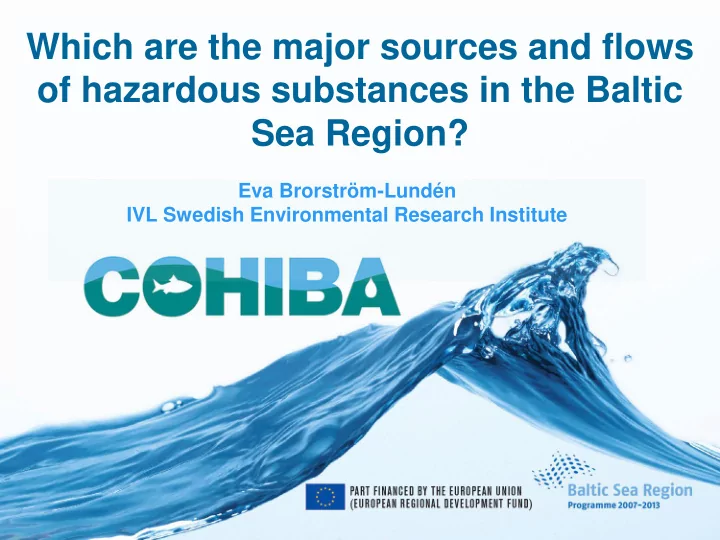

Which are the major sources and flows of hazardous substances in the Baltic Sea Region? Eva Brorström-Lundén IVL Swedish Environmental Research Institute
Major sources and pathways of hazardous substances All partners in the COHIBA project have been involved contributing by collecting data and participation in the assessments Leader: IVL, Swedish Environmental Research Institute Eva Brorström-Lundén, Hanna Andersson, Anna Palm-Cousins, Sweden: City of Stockholm; Tonie Wickman, Maria Pettersson, Arne Jamtrot, Katrin Holmström, Swedish Chemicals Agency; Stellan Fischer, Helena Parkman Poland: Janusz Krupanek, IETU, Katowice Finland: Jukka Mehtonen, Matti Verta, Päivi Munne, SYKE Estonia: Epp Volkov, Mailis Lath, Estonian Environmental Research Centre, Ülle Leisk Tallinn University of Technology Lithuania: Juste Buzelyte, Goda Gudienė , Baltic Environmental Forum Latvia: Valters Toropovs, Juris Fridmanis, Baltic Environmental Forum Germany: Cindy Mathan, UBA, Frank Marscheider-Weidemann, Eve Menger-Krug Fraunhofer Institute for Systems and Innovation Research ISI Denmark: Ulf Nielsen, DHI
Identification of sources and estimation of inputs/impacts on the Baltic Sea Overall aim To produce a picture of the sources, releases and inputs of the selected substances (BSAP) linked to the effects in the Baltic Sea marine environment, which is as complete as possible with today's knowledge
Major sources and flows of hazardous substances in the Baltic Sea Region An overview of important findings Identification and assessment of emissions of the target substances using substances flow analyses (SFA) The importance of atmospheric transport and deposition for the occurrence of selected substances in the Baltic Sea Fate assessment and estimation of inputs of hazardous substances using a multimedia model
Target substances 1. Dioxins (PCDD), furans 5. Hexabromocyclododecane (PCDF) and dioxin-like PCBs (HBCDD) 6. Nonylphenols (NP), 2. Tributyltin compounds (TBT), nonyphenol ethoxylates (NPE) triphenyltin compounds (TPhT) 7. Octyphenols (OP), octyphenol ethoxylates (OPE) 3. Pentabromodiphenyl ether (pentaBDE), 8. Short-chain chlorinated octabromodiphenyl ether paraffins (SCCP), medium- (octaBDE), chain chlorinated paraffins decabromodiphenyl ether (MCCP) (decaBDE) 9. Endosulfan 4. Perfluorooctane sulfonate 10.Mercury (PFOS), Perfluorooctanoid 11.Cadmium acid (PFOA)
Identification of sources and estimation of inputs/impacts on the Baltic Sea Available information on use patterns and emissions have been collected Substance flow analyses (SFA) have been conducted in all Baltic Sea countries participating in the project A unique dataset of emission estimates for substances listed in the Baltic Sea Action Plan (BSAP-substances) have been created. The dataset includes almost 2000 emission estimates The most important emission sources in the Baltic Sea region and inputs and flows to the Baltic Sea have been identified but data gaps on emissions and environmental concentrations have been found. These data gaps introduce high uncertainties in the results The dataset will be updated to the final reporting
Emissions of the BSAP-substances: distribution between compartments Differences among the substances were identified 100% 90% 80% Surface water: NP, NPE, 70% 60% OP, OPE 50% 40% Surface water 30% Land: PBDE, SCCP, 20% Land 10% Air MCCP 0% Air: PCDDS, PDCF Hg, Cd
Atmospheric transport and deposition an important pathway to the Baltic Sea? The input of selected substances via the atmosphere has been put in relation to other sources Deposition fluxes to the Baltic Sea and the Baltic Sea catchment area has been estimated using monitoring data Deposition are measured at three sites using a sampler which consists of 1m 2 surface open to the air all the time Data from 2009 and 2010 was used
Estimated yearly atmospheric deposition of PBDE Deposition to the Baltic Sea surface - 80 kg/year Deposition to the total catchment area – 380 kg/year The estimated total emissions in the Baltic sea catchment Low scenario - 100 kg/year High scenario - 400 kg/year
Estimated yearly atmospheric deposition of endosulfan Sum alpha- beta and endosulfan- sulfat Deposition to the Baltic Sea surface - 100 kg/year Deposition to the total catchment area - 400 kg/year The estimated total emissions in the Baltic sea catchment Low scenario - 180 kg/year High scenario - 350 kg/year
POP-CYCLING Baltic Model T1 T1 Bothnian Bay Bothnian Bay C1 Coastal C1 Coastal A1 A1 Bothnian Bay Bothnian Bay North North O1 Open O1 Open Bothnian Bothnian Bay Bay C2 Coastal C2 Coastal T2 T2 T4 T4 Bothnian Sea Bothnian Sea Bothnian Sea Bothnian Sea Neva Neva T10 T10 O2 Open O2 Open A2 A2 C3 Coastal C3 Coastal Bothnian Bothnian Skagerrak Skagerrak East East Gulf of Gulf of Sea Sea T3 T3 C4 C4 C10 Coastal C10 Coastal Finland Finland A4 A4 Gulf of Gulf of Neva Neva Skagerrak Skagerrak O3 Open O3 Open T7 T7 West West Finland Finland Gulf of Gulf of Swedish Swedish C7 C7 O6 Open O6 Open T9 T9 T5 T5 Finland Finland Swedish Swedish Baltic Baltic Skagerrak Skagerrak O4 O4 Kattegat Kattegat Gulf of Gulf of Baltic Baltic Open Open C5 Gulf of C5 Gulf of Proper Proper Proper Proper Riga Riga Riga Riga C9 C9 Baltic Baltic T8 T8 Proper Proper Kattegat Kattegat Danish Danish O5 O5 Bottom Bottom A3 A3 C8 C8 Straits Straits C6 C6 water water Danish Danish South South Southern Southern T6 T6 Straits Straits Baltic Baltic Southern Southern Proper Proper Baltic Proper Baltic Proper atmospheric environment terrestrial environment marine environment Wania F., Persson J., Di Guardo A., McLachlan M. NILU 0R 10/2000
Model predicted input pathways to the Baltic Sea for different chemicals - only emissions within region considered ! Direct emission 3 % 9 % 38 % Riverine input BDE 47 59 % Atmospheric deposition 88 % 3 % 3 % 11 % 43 % BDE 99 53 % 86 % 4 % 4 % 27 % 9 % BDE 209 68 % 5 % 87 % Low emission scenario High emission scenario
Model predicted input pathways for different chemicals to the Baltic Sea -only emissions within region considered! 2 % 5 % 3 % 0 % Direct emission Riverine HBCDD input Atmospheric 92 % 98 % deposition 3 % 0 % 2 % 6 % ENDO- SULFAN 92 % 97 % 3 % 0 % 1 % 1 % NP/NPE 97 % 98 % Low emission scenario High emission scenario
THANK YOU!
Recommend
More recommend